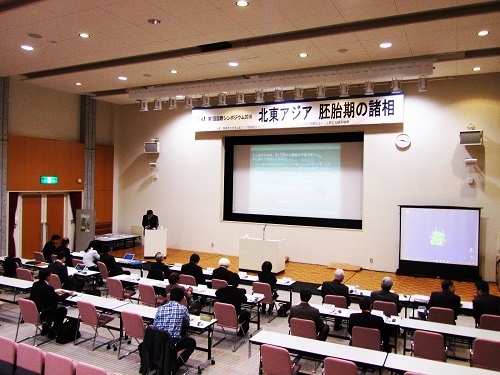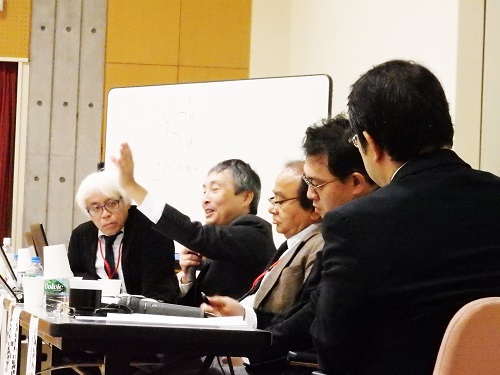No.006 - National Institutes for the Humanities (NIHU) Northeast Asia Area Studies Project University of Shimane NEAR Center Project “Formation of Modern Spaces and their Impact” 1st International Symposium 2016 Northeast Asia: The Embryonic Stage
National Institutes for the Humanities (NIHU) Northeast Asia Area Studies Project
University of Shimane NEAR Center Project “Formation of Modern Spaces and their Impact”
1st International Symposium 2016
Northeast Asia: The Embryonic Stage
Toru ISHIDA, University of Shimane
The symposium mentioned above took place over the course of a weekend, on November 19 and 20, 2016. Due to space constraints, I’m sure you will understand that I cannot go into full detail of all comments and questions during the event.
The first symposium as part of this project, and the first held at the Institute for North East Asian Research (NEAR Center), the event consisted of three sessions and a general debate, with the first two sessions taking place on the Saturday, and the third session and debate on the Sunday. The symposium was based on the premise that the period up to the 18th century (mainly the 17th century) in Northeast Asia was an “embryonic stage,” during which the foundations were laid for the “preliminary stage” from the 19th century onwards, as modernization began to sweep across the region. Discussions revolved around the situation in each country in the region during that period, approaching the subject from three key perspectives; “perceptions,” “ruling philosophies” and “exchange.”
The first session was chaired by Xiao Dong Li (University of Shimane). Entitled “Perceptions: Self-Perception or History,” it featured four reports, followed by comments and questions with Hiroki Oka (Tohoku University). A report from Tomoyasu Iiyama (Waseda University), entitled “12th-14th Century Northern China – the Borderland Between Mongolia and China,” went back further than the 17th-18th century focus of the symposium to look at the northern part of China during the 12th to 14th centuries. He discussed the fact that northern China was strongly characterized as a borderland between the typically “Northern Asian” aspects of Mongolian culture and the Jiangnan region of China. Osamu Inoue (University of Shimane) meanwhile gave a report entitled “Research into Mongolian Chronicles and their Effects on Subsequent Generations.” He provided an overview of numerous “Mongolian chronicles” written from the 17th to the 19th centuries, and outlined a direction for continuing research in the future. The next report, from Atsushi Inoue (University of Shimane), was entitled “Differing Perceptions between Korea and Japan.” He talked about the impact that the Mongol invasions of Japan had on perceptions in both Japan and Korea, referring to sources such as the “Goryeosa (History of Goryeo),” “Annals of the Joseon Dynasty,” “Taiheiki (Chronicle of Great Peace)” and “Jinno Shotoki (Chronicles of the Authentic Lineages of the Divine Emperors).” Yoshikazu Nakamura (Professor Emeritus, Hitotsubashi University) gave a report on “The Utopia Legend (Belovodye) of the Russian Old Believers.” He spoke about the “Old Believers” (former followers), who emerged from the mid-17th century movement to reform the Russian Orthodox Church, and their fascination with the east, which they passed on through the generations by maintaining belief in the legend of utopia.
The second session, chaired by myself, was themed around “ruling philosophies,” and once again featured four reports followed by comments and questions with Xiao Dong Li. Takeo Kuryuzawa (Professor Emeritus, Hokkaido University) gave a report entitled “Ruling Philosophies in Russia during the Embryonic Stage.” He provided an overview of Russian history from 9th century Kiev onwards, and discussed key aspects of Russia’s relationship with Asia. This was followed by a report by Toshio Motegi (Tokyo Woman’s Christian University), entitled “Chinese Philosophies on Order.” He discussed the shape of order in China during the pre-modern era, while also looking at various “transformations” that have occurred in the modern era. Hiroki Oka gave a report on “The Qing Dynasty’s Rule over Mongolia in the Context of Mongolian History.” He explained that there was no “inner and outer” structure between the Qing Dynasty and Mongolia, highlighting the multifaceted nature of rule under the Qing Dynasty, based on a concurrent yet different historical context. Hyeon-Cheol Do (Yonsei University, South Korea) gave a report on “The Relationship between Neo-Confucian Ruling Philosophies under the Joseon Dynasty and China.” He discussed the reasons why Neo-Confucianism became the norm under the Joseon Dynasty, the inner workings of public opinion and politics during that era, and perceptions of the tributary-investiture relationship with China.
The following day, the third session on the 20th was chaired by Jianhui Liu (International Research Center for Japanese Studies) and was based on the theme of “exchange.” It featured two reports, followed by comments and questions with Tsuneo Namihira (University of the Ryukyus), Naoki Amano (Yamagata University) and Osamu Inoue. The first report was from Dong Yu Han (Northeast Normal University, China), entitled “The Academic Debate Surrounding the Issue of Self-Control in Pre-Modern Japan and China.” He discussed how the concept of “self-control” was portrayed in classical Chinese literature, and how it was received and understood when it came over to Japan. Akira Yanagisawa (Waseda University) then gave a report entitled “Russian-Chinese Diplomacy and Intermediary Languages in the 17-19th Centuries,” focusing discussion on which languages were used in negotiations between Qing Dynasty China and Russia during the 17th to 19th centuries, while also looking at translation systems and translator training.
This was followed by a general debate, chaired by Atsushi Inoue. The session began with a summary debate between a panel of four speakers, with Hiroki Oka, Naheya (Inner Mongolia University, China) and Eduard Baryshev (University of Tsukuba) joined on short notice by Yuki Konagaya (NIHU), before moving on to a question and answer session with speakers who had given reports. Yuki Konagaya summed up the symposium using the phrase “civilizations (i.e. the foundations that different cultures share) coming together.” She commented that, while there is real diversity between regions within Northeast Asia, embracing that diversity makes it possible to achieve a sense of stability, and pointed out that these two key points were evident in each of the reports. She also recommended taking into account the concepts of space and location when thinking about the Northeast Asia region on a conceptual level, and commented that working with the National Museum of Ethnology would be a viable option when it came to examining how different cultures come together.
Hiroki Oka referred to the “curious stability” and “diversity” of Northeast Asia, before raising the two questions of how to view Northeast Asia as a region and how to tackle research into the region. He stressed the importance of “paying more attention to the north,” particularly in Japan. Naheya meticulously commented on and questioned each of the ten reports, while Eduard Baryshev singled out the “presence and dynamism of Mongolia” as one of the overriding features of the symposium. He also commented that Northeast Asia is a geographical reality and a space that is transforming itself, as it moves further away from the issue of ethnicity, and pointed out that Northeast Asia as a space depends on the relationships between those who make up the region. He finished by underlining the “presence and significance of the north,” and posing important questions regarding the symposium’s lack of any “western” input and the position of Japan within Northeast Asia.
I am already running out of space, but would just like to briefly share my thoughts on this event. As you can tell from the above, this symposium was an extensive, far-reaching affair, with western representatives from Kiev and Moscow alongside eastern counterparts from the Korean Peninsula and Japan, and a timeframe ranging from the 9th to the 17th centuries. It was an opportunity to experience “the contents of four conferences in one” (Konagaya). Although I myself chaired the second session, I must confess that I did get a little lost when the subject of the symposium turned to the west and the north. Having focused largely on the history of relations between Japan and Korea myself, I found I had trouble absorbing what was being said. Needless to say, this was due to my own lack of knowledge about the west and north, or moreover down to a lack of study on my part. Although, I wonder if this was also due to the absence of perspective on the entirety of Northeast Asia and method to consider Northeast Asia in a systematic manner.
How should we structure the history of Northeast Asia, or the history of Northeast Asian thought, which is not a collection of histories of each nation? There is a common saying “it’s always darkest before the dawn.” I think that describes this symposium perfectly. The more discussions progressed, the less clear things became. The key to overcoming this issue can be found in some of the ideas raised during the general debate. These include “the importance of the north (Mongolia/Russia)” and “mechanisms to enable us to accept differences and embrace diversity,” which after all is one of the defining characteristics of Northeast Asia. I may be wide of the mark, but personally, I found myself wondering if it might be worth re-reading Tadao Umesao’s “An Ecological View of History,” to avoid falling into the trap of focusing on “transhistorical notions.” The symposium gave me a real sense of the impact that lifestyles in Mongolia had on culture. I hope we can use this symposium as a stepping stone towards tackling this issue in the future, so that we can all welcome in the dawn.
(Note: This article is an edited version of a piece with the same name, due to be published in NEAR News No.51 (March 2017), the official newsletter of University of Shimane NEAR Center.)

Img1: The symposium was held at the University of Shimane

Img2: Participants discuss issues during a session
